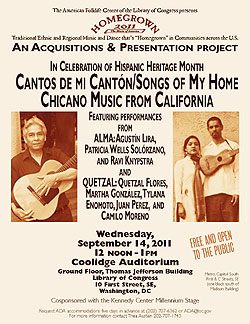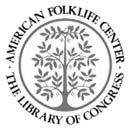| |
|||
|
The American Folklife Center at the Library of Congress presentsThe Homegrown 2011 Concert Series
|

|
In the 1960s while the folk sounds of Bob Dylan, Joni Mitchell, Joan Baez and Phil Ochs provided an entrance for many young Americans to the Civil rights movement, people from "way, way below" in California were drawing attention to a "cause" that utilized music, theater, and protest to illuminate the horrid conditions in which they were working and living. The Farm Workers Movement that gained widespread attention with the Delano Grape Strike of 1965 gave birth not only to a political bloc but also to a flowering of expressive culture. Agustín Lira, a field worker and later a founder of El Teatro Campesino, witnessed and contributed immensely to this movement. La Causa as the movement was known, was characterized by political rallies, protests, and marches from the mid 1960s through the 1970s. From these events emerged the powerful political voices of Reies López Tijerina, Rodolfo "Corky" González, Dolores Huerta, and Cesar Chavez.
Vibrant soundscapes of chants, gritos (yells), prayers, poetry, and music also arose from these gatherings. Groups such as El Teatro Campesino, Flor del Pueblo, and Los Alacranes Mojados produced songs for these congregations. The compositions challenged the dominant powers, which marginalized community members into the military, low-income housing and schools, racist healthcare institutions, and second-class citizenship. The music illuminated the resilience of these aggrieved communities and demonstrated how they maintained culture, promoted consciousness, celebrated, and preserved dignity.
Agustín Lira is one of the cultural pioneers of the Chicano movement's musical style. He worked also as an actor, writer, composer, and activist, continuously offering his guitar, voice, and mind to the trials that confronted his community. Today, Lira, his partner Patricia Wells Solórzano, and bassist Ravi Knypstra form the ensemble Alma. Founded in 1979, the goal of Alma was to make evident, through expressive culture, the hidden stories of Chicana/os and Mexicana/os who contributed to our history. After attending university, Wells Solórzano decided to develop her skills as a singer and lead guitarist, which complemented Lira’s musical direction as a singer-songwriter. Knypstra, a much sought after player in Los Angeles rounded out the group, offering experience in styles such as blues, country, rock, and jazz.
As is common in the tradition of Chicano music, Agustín Lira and Alma includes a variety of genres, forms, and influences from Mexico, Latin America, and the United States. The ensemble falls in a lineage of creative musical development that includes Don Tosti, Eddie Cano, and Eduardo "Lalo" Guerrero, who sang in English, Spanish and Caló (an argot combining Spanish and English slang). In addition to mixing languages, these musicians mixed musical forms of jazz and blues with rancheras, huapangos, and Latin dance music. One of the more popular people of this lineage in California is Ritchie Valens, whose 1958 version of the Mexican folksong "La Bamba" made this song an international hit. Los Lobos' 1987 version of the same song became a No. 1 hit in the US and UK pop charts, creating a path for new groups in the 1990s.
In 1992 the group Quetzal surfaced during a particularly contentious time, characterized by the Los Angeles uprising in response to the Rodney King beating, and the Zapatista insurrection in Mexico. These events spurred a powerful synergy in which people utilized expressive culture as an organizing platform to voice desires, opinions, and resistance to the conditions in which they found themselves. Quetzal came from this milieu along with many other ensembles such as Aztlán Underground, Ozomatli, and Lysa Flores. Guitarist Quetzal Flores (of the group Quetzal) viewed the work of these groups not so much as a reaction to a specific political or social crisis, but as a proactive strategy to maneuver through the societal problems that affected the communities in which these musicians lived.
Flores and his group were interested in composing music that reflected their community's experience in Los Angeles. The group developed a distinctive sound when vocalist, dancer and composer Martha González joined forces with Flores. Together they fused every type of music and technology available to them, including folk instruments like the tarima (a small wooden platform which is danced upon), jarana (a small rhythm guitar), and requinto (a melodic guitar) of the jarocho tradition of Southern Veracruz, together with contemporary grooves and feels of rock and jazz.
The ensemble is rounded out with long time member Tylana Enomoto, who provides inspired playing influenced by her participation in everything from classical to hip hop; East LA bassist Juan Perez, who has facilitated Quetzal's transnational dialogue between Chicana/o artists from California and jarocho musicians and dancers from Southern Veracruz by working with both Quetzal and the jarocho ensemble Son de Madera; and Camilo Moreno, who hails from a lineage of musicians from Pasto, Colombia—his father was a member of the popular salsa group Niche. As an expression of the Mexican-American experience, Chicano music has been and continues to be a major element in the development of US culture. At the same time, Chicana/o musicians throughout history have consistently contributed to the soundscape of our nation in the form of popular love songs, dance music, instrumentals, parodies, and scores for theater, film and documentaries, contributing immensely to the process of music making within the United States.
Russell C. Rodríguez, PhD
Consultant, Alliance for California Traditional Arts
 The American Folklife Center was created by Congress in 1976 and placed at the Library of Congress to "preserve and present American Folklife" through programs of research, documentation, archival preservation, reference service, live performance, exhibition, public programs, and training. The Center includes the American Folklife Center Archive of folk culture, which was established in 1928 and is now one of the largest collections of ethnographic material from the United States and around the world. Please visit our web site.
The American Folklife Center was created by Congress in 1976 and placed at the Library of Congress to "preserve and present American Folklife" through programs of research, documentation, archival preservation, reference service, live performance, exhibition, public programs, and training. The Center includes the American Folklife Center Archive of folk culture, which was established in 1928 and is now one of the largest collections of ethnographic material from the United States and around the world. Please visit our web site.
| ||||
